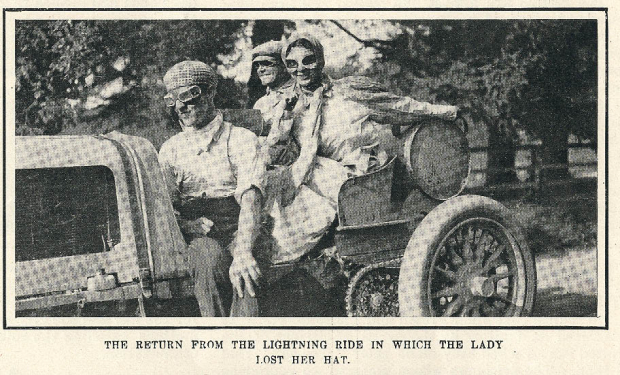Pioneer Harriet Quimby’s Exciting Ride in a Racing Motor-Car in October 1906

Harriet Quimby (1875-1912) was noted for her daring courageous spirit , intelligence and beauty. She initially achieved fame as one of the first woman to work as a newspaper reporter and ,then, as a journalist and theater critic for a national magazine Leslie's Illustrated Weekly from 1902 to 1912.
On October 4, 1906, two days away from the Vanderbilt Cup Race, Leslie's Illustrated Weekly published Harriet Quimby's article A Woman's Exciting Ride in a Racing Motor-car. Here are some highlights from the article describing her ride in a Vanderbilt Cup racer. It began at the Pope-Toledo's headquarters located on Glen Cove Road and Northern Boulevard in Greenvale (now across the street from Ben's Deli in Wheatley Plaza!):
"Just now the eyes of the motoring world, both in this country and abroad, are focused on the Vanderbilt course on Long Island, over which one of the greatest races ever run in America will take on the sixth of October...One by one the various machines which will compete have appeared on the scene, and each is installed in its own plant with a crew of mechanicians and chauffeurs, and also the chosen drivers, who are the leading men of the hour in more senses of the world than one. Even the man who manufactures the machine, and who is helping to finance the race, takes a back seat for the time being, and kotows to the driver who will do everything toward maintaining the established make of an old company, or compel the world to accept the products of a new one."
"Through the courtesy of Mr. A. E. Schaaf, manager of the company that build the Pope-Toledo car, a crew of mechanicians, and last, but not least, a driver who thought twice before he gave his consent, the writer was permitted not only to approach and pat one of the closely guarded iron flyers of 120 horsepower which will compete in the race, but she was also allowed actually to sit in it, and to hang on for dear life while Herbert Lytle, its driver, put it through its paces."
"You are now going at about seventy miles an hour, and you feel the swift currents of air produced by the mad flight of the machine... A curve and a sharp angle there are thirteen curves on the course- you slow down to about fifty, and the car careens virtually on one wheel, and the whole machine seems lifted up in the air and comes down to earth again with a jump. You are so busy with the register, your hat, and the corner that you did not hear the lever click into fourth speed, but you feel the car -zip!- for the fraction of a minute you are going a trifle over a hundred miles an hour. You think, if indeed you think at all, that if it goes much faster you will topple right over, but soon you begin to slow down, seventy, sixty, fifty. Why you seem to actually crawl along at fifty an hour, and although every nerve in your body is quivering and you have just enough strength to hang on to the strap, you manage to shout an answer to Lytle, who asks with exquisite sarcasm, at the top of his voice, "Was that fast enough?" and you enjoy the satisfaction of seeing him nearly fall over with surprise as you fire back "Twasn't very fast; can't you make one hundred and twenty?"
"After you have reached the plant again and received the congratulations of the half-frightened group which has been speculating about your safe return...You are glad enough to start for home again, but you will remember for many a day how it seems to fly, and you wonder if next year's racers will be able to accomplish as much even in the way of speed and general equipment."
By 1911, Harriet became fascinated by the challenge of aviation and became the first woman to receive a pilot's license in the United States. In the spring of 1912, which continuing her Leslie's journalism career, she became the first woman to fly across the English Channel. Tragically, on July 1, 1912, at an aviation exhibition near Quincy, Massachusetts, Harriet and the manager of the air meet fell to their deaths when her airplane pitched forward.
Harriet Quimby helped overturn stereotypes of woman in society. An independent pioneering woman ahead of her time, she was an inspiration for Amelia Earhart and is a role model for the generations that followed.
A 4-minute film on Harriet Quimby by the International Women's Air & Space Museum:
Links to related posts:
Archives: 1906 Vanderbilt Cup Race







Comments
Hooray for Harriet Quimby - keep those fine
articles coming, Howard!
Thanks for the fascinating article and video on Harriet Quimby.
Harriet Quimby’s efforts in aviation on Long Island is the reason why—-the Cradle of Aviation Museum is right here. After the Wright Brothers most of the important aviation firsts were right here on L.I. Even the landing on the Moon was a Long Island feat—-Grumman and the LEM. Ms.Quimby loved speed and if it was not in experiencing flight, she was on the ground in fast moving automobiles. She was not just a remarkable woman she was a remarkable pioneer of 20th century travel.
Super feedback and comments!!